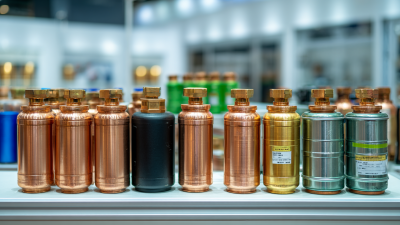




In the realm of HVAC systems, the Air Conditioner Filter Drier plays a pivotal role in ensuring optimal performance and longevity of cooling units. According to the American Society of Heating, Refrigerating and Air-Conditioning Engineers (ASHRAE), inadequate maintenance of air conditioning systems can lead to a 10-30% increase in energy consumption, with filter driers significantly impacting overall efficiency. These components are crucial for filtering out contaminants and moisture from refrigerants, thereby protecting crucial system parts from corrosion and wear. Furthermore, the U.S. Department of Energy estimates that properly maintained HVAC systems can save homeowners up to 30% on cooling costs annually, underscoring the importance of features like the Air Conditioner Filter Drier. Understanding how this component functions and its significance in the HVAC ecosystem can lead to more efficient operations and reduced energy expenditures.

The air conditioner filter drier plays a pivotal role in enhancing the efficiency of HVAC systems. By removing impurities and moisture from the refrigerant, the filter drier ensures that the system operates smoothly. Moisture contamination can lead to corrosion inside the components and contribute to refrigerant degradation, ultimately resulting in reduced system efficiency and heightened energy consumption. By maintaining optimal fluid quality, the filter drier not only extends the life of the HVAC system but also promotes energy savings over time.
Additionally, the filter drier assists in preventing blockages in the refrigerant lines. It captures debris and particles that could impede the flow of refrigerant, thus maintaining a consistent and efficient performance of the air conditioning system. This is especially crucial during peak usage periods when even slight inefficiencies can lead to significant increases in operational costs. By understanding the importance of the filter drier, homeowners and facility managers can ensure their HVAC systems function at peak performance, contributing to a more environmentally friendly and cost-effective operation.
When selecting the right filter drier for your HVAC system, it’s essential to consider several critical factors that will optimize performance and enhance efficiency. A filter drier plays a crucial role in removing moisture and contaminants from the refrigerant, which helps prevent compressor damage and maintains system reliability. Look for models that match the capacity and type of your HVAC system to ensure effective filtration and drying.
**Tips:** Always check the specifications of your HVAC unit before purchasing a filter drier. Compatibility is vital, as using an incompatible filter can lead to inefficiencies and increased maintenance issues. Consider choosing a filter drier with a sight glass for easy monitoring of moisture levels, which can help you take timely action to maintain optimal performance.
Additionally, pay attention to the filter drier's size and type. There are various options available, including disposable and replaceable types. Make sure to select a filter drier that aligns with your system requirements and provides high absorbent capacity. Regular maintenance and timely replacement of the filter drier can significantly extend the lifespan of your HVAC system, leading to better air quality and energy savings.

When it comes to HVAC systems, the air conditioner filter drier plays a crucial role in maintaining efficiency and prolonging the lifespan of your unit. Understanding the signs that indicate your filter drier needs replacement can save you from costly repairs and ensure optimal performance during the warm months. Common signs include unusual noises from the AC unit, fluctuating indoor temperatures, or reduced cooling efficiency. If you notice moisture buildup or ice formation on the refrigerant lines, these could be signals that the filter drier is becoming clogged or failing.
Regular maintenance is key to avoiding issues with your filter drier. Just as it's essential to clean your AC unit periodically to improve its efficiency, a proactive approach to replacing your filter drier when necessary can help mitigate issues stemming from debris or contaminants in the refrigerant lines. Be attentive to these warning signs and don’t hesitate to consult with HVAC professionals when in doubt, as timely intervention can significantly enhance the overall air quality and comfort of your home.
Maintaining the filter drier in your HVAC system is crucial for its longevity and efficiency. Regular inspection and replacement of the filter drier can prevent moisture buildup and contamination, which can significantly impair the overall performance of your air conditioning system. It’s recommended to check the drier every six months, especially before the peak summer months. If you notice any signs of wear, such as rust or discoloration, it’s essential to replace it promptly to avoid costly repairs down the line.
In addition to regular inspections, keep the surrounding area clean and free of debris. A clutter-free environment helps ensure proper airflow and prevents external contaminants from entering the system. Additionally, monitoring the refrigerant levels can aid in identifying potential issues before they escalate. If you suspect any leaks, contact a professional to service your system and replace any faulty components. By adhering to these maintenance tips, you can extend the life of your filter drier and ensure your HVAC system operates at peak performance.

In HVAC systems, both filter driers and accumulators play crucial roles in maintaining optimal performance, yet their functions and applications differ significantly. A filter drier primarily serves to remove moisture and impurities from the refrigerant, protecting the system components from corrosion and ensuring efficient thermal exchange. It contains a desiccant material that absorbs water vapor and a filtration mechanism that captures particulate matter, which can otherwise lead to blockages or damage over time. This essential component is typically found in liquid lines, making it integral to the refrigeration cycle.
On the other hand, an accumulator is designed to manage excess refrigerant and prevent liquid refrigerant from entering the compressor. It acts as a buffer, allowing the system to stabilize and ensuring that only gaseous refrigerant reaches the compressor, thus protecting it from potential hydraulic lock. This is particularly important in systems with fluctuating load conditions or during low-pressure scenarios, where liquid could inadvertently flow back. Understanding these differences is vital for HVAC professionals in selecting the appropriate component for specific applications, ultimately enhancing system reliability and efficiency.
This chart illustrates the differences in efficiency between filter driers and accumulators in HVAC systems based on various performance metrics.








